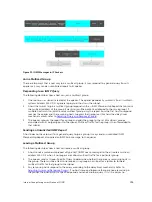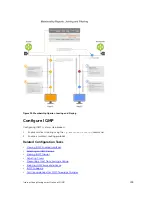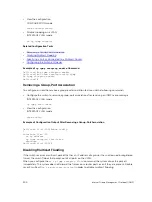
IGMP querying router is 1.1.1.1 (this system)
IGMP version is 3
Viewing IGMP Groups
To view both learned and statically configured IGMP groups, use the following command.
• View both learned and statically configured IGMP groups.
EXEC Privilege mode
show ip igmp groups
Example of the
show ip igmp groups
Command
Dell# show ip igmp groups
Total Number of Groups: 2
IGMP Connected Group Membership
Group Address Interface Mode Uptime Expires Last Reporter
225.1.1.1 TenGigabitEthernet 1/1 IGMPV2 00:11:19 00:01:50 165.87.34.100
225.1.2.1 TenGigabitEthernet 1/1 IGMPV2 00:10:19 00:01:50 165.87.31.100
Adjusting Timers
The following sections describe viewing and adjusting timers.
To view the current value of all IGMP timers, use the following command.
• View the current value of all IGMP timers.
EXEC Privilege mode
show ip igmp interface
For more information, refer to the example shown in
Viewing IGMP Enabled Interfaces
Adjusting Query and Response Timers
The querier periodically sends a general query to discover which multicast groups are active. A group
must have at least one host to be active.
When a host receives a query, it does not respond immediately, but rather starts a delay timer. The delay
time is set to a random value between 0 and the maximum response time. The host sends a response
when the timer expires; in version 2, if another host responds before the timer expires, the timer is
nullified, and no response is sent.
The maximum response time is the amount of time that the querier waits for a response to a query
before taking further action. The querier advertises this value in the query (refer to the illustration in
). Lowering this value decreases leave latency but increases response burstiness because all host
membership reports must be sent before the maximum response time expires. Inversely, increasing this
value decreases burstiness at the expense of leave latency.
When the querier receives a leave message from a host, it sends a group-specific query to the subnet. If
no response is received, it sends another. The amount of time that the querier waits to receive a response
to the initial query before sending a second one is the last member query interval (LMQI). The switch
waits one LMQI after the second query before removing the group from the state table.
• Adjust the period between queries.
Internet Group Management Protocol (IGMP)
301
Summary of Contents for Z9000
Page 1: ...Dell Configuration Guide for the Z9000 System 9 7 0 0 ...
Page 80: ...grub reboot 80 Management ...
Page 128: ... 0 Te 1 1 Te 1 2 rx Flow N A N A 128 Access Control Lists ACLs ...
Page 491: ...Figure 70 Configuring OSPF and BGP for MSDP Multicast Source Discovery Protocol MSDP 491 ...
Page 496: ...Figure 73 MSDP Default Peer Scenario 1 496 Multicast Source Discovery Protocol MSDP ...
Page 497: ...Figure 74 MSDP Default Peer Scenario 2 Multicast Source Discovery Protocol MSDP 497 ...
Page 498: ...Figure 75 MSDP Default Peer Scenario 3 498 Multicast Source Discovery Protocol MSDP ...
Page 760: ...Figure 100 Single and Double Tag TPID Match 760 Service Provider Bridging ...
Page 761: ...Figure 101 Single and Double Tag First byte TPID Match Service Provider Bridging 761 ...






























